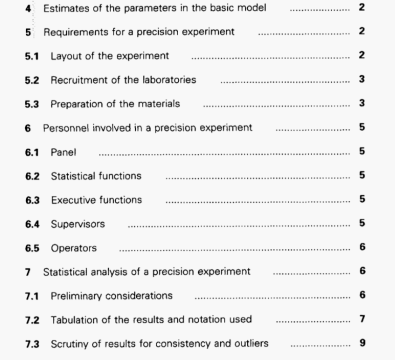ISO 5725-2 pdf download – Accuracy (trueness and precision) of measurement methods and results一 Part 2: Basic method for the determination of repeatability and reproducibility of a standard measurement method.
7.3.1.3 Examination of the h and k plots may indicate that specific laboratories exhibit patterns of results that are markedly different from the others in the study. This is indicated by consistently high or low within-cell variation and/or extreme cell means across many levels. If this occurs, the specific laboratory should be contacted to try to ascertain the cause of the discrepant behaviour. On the basis of the findings, the statistical expert could:
a) retain the laboratory’s data for the moment.
b) ask the laboratory to redo the measurement (if feasible);
c) remove the laboratory’s data from the study.
7.3.1.4 Various patterns can appear in the h plots. All laboratories can have both positive and negative h values at different levels of the experiment. Individual laboratories may tend to give either all positive or all negative h values, and the number of laboratories giving negative values is approximately equal to those giving positive values. Neither of these patterns is unusual or requires investigation. although the second of these patterns may suggest that a common source of laboratory bias exists On the other hand, if all the h values for one laboratory are of one sign and the h values for the other laboratories are all of the other sign, then the reason should be sought. Likewise, if the I. values for a laboratory are extreme and appear to depend on the experimental level in some systernatic way, then the reason should be sought. Lines are drawn on the h plots corresponding to the indicators given in 8.3 (tables 6 and 7). These indicator lines serve as guides when examining patterns in the data.
7.3.1.5 If one laboratory stands out on the k plot as having many large values, then the reason should be sought: this indicates that it has a poorer repeatability than the other laboratories. A laboratory could give rise to consistently small k values because of such factors as excessive rounding of its data or an insensitive measurement scale. Lines are drawn on the k plots corresponding to the indicators given in 8.3 (tables 6 and 7). These indicator lines serve as guides when examining patterns in the data.
7.3.1.6 When an h or k plot grouped by laboratory suggests that one laboratory has several h or k values near the critical value line, the corresponding plot grouped by level should be studied. Often a value that appears large in a plot grouped by laboratory will turn out to be reasonably consistent with other laboratories for the same level. If it is revealed as strongly different from values for the other laboratones, then the reason should be sought.
7.3.1.7 In addition to these h and & graphs. histograms of cell means and cell ranges can reveal the presence of, for example, two distinct populations. Such a case would require special treatment as the general underlying principle behind the methods described here assumes a single unimodal population.
7.32 Numerical outher technique
7.3.2.1 The following practice is recommended for dealing with outliers.
a) The tests recommended in 7.3.3 and 7.3.4 are applied to identify stragglers or outIiers
— if the test statistic is less than or equal to its 5 % critical value, the item tested is accepted as correct;
— if the test statistic is greater than its 5 % critical value and less than or equal to its 1 %
critical value, the item tested is called a
straggler and is indicated by a single asterisk;
— if the test statistic is greater than its 1 % critical value, the item is called a statistical outlier and is indicated by a double asterisk.
b) It is next investigated whether the stragglers and/or statistical outliers can be explained by some technical error, for example
— a slip in performing the measurement,
— an error in computation,
— a simple clerical error in transcribing a test result, or
— analysis of the wrong sample.
Where the error was one of the computation or transcription type, the suspect result should be replaced by the correct value: where the error was from analysing a wrong sample, the result should be placed in its correct cell. After such correction has been made, the examination for stragglers or outliers should be repeated.
ISO 5725-2 pdf download – Accuracy (trueness and precision) of measurement methods and results一 Part 2: Basic method for the determination of repeatability and reproducibility of a standard measurement method
